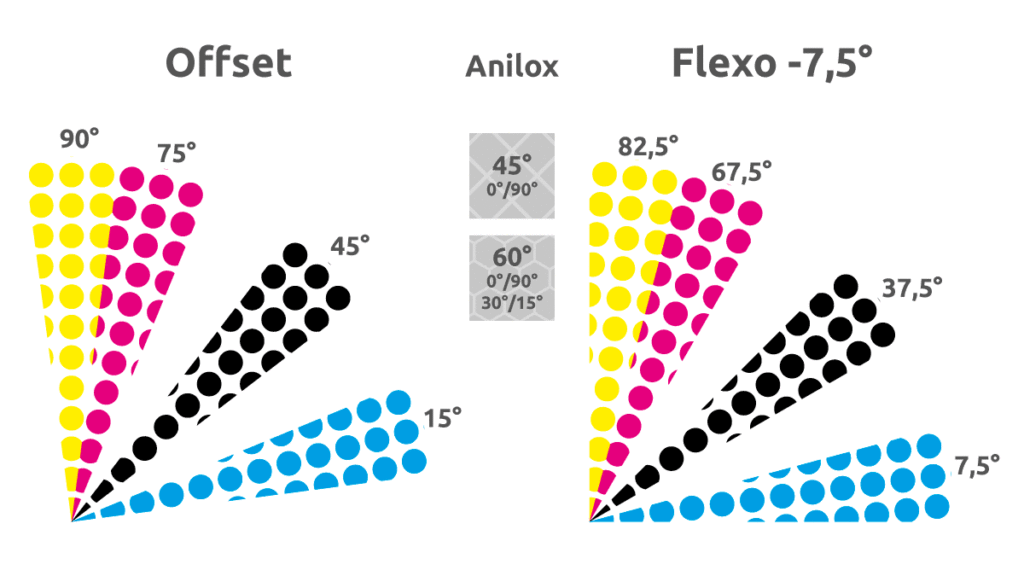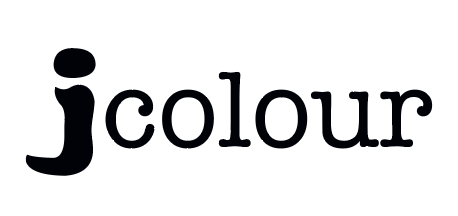Screen angles in flexography 柔版印刷中的加网角度

Have you ever wondered why we need to use different screen angles in flexography?
您有没有想过为什么我们需要在柔版印刷中使用不同的加网角度?
First of all we need to remember that we consider the screen angles when we look at the final printed product, so the parameters we set in the prepress/imaging workflow are meant to obtain the angles as described.
首先,我们需要记住,当我们查看最终的印刷产品时,我们会考虑加网角度,因此我们在印前/成像工作流程中设置的参数旨在获得所描述的角度。
Then we need to consider the origin of such angles and the reason why we set CMYK primary colours on certain angles.
那么我们就需要考虑这些角度的由来,以及为什么我们在某些角度上设置CMYK原色的原因。
The human eye can better distinguish a repeated pattern made by dots when they lay over an orthogonal structure, thus vertical and horizontal. At the same time, the human eye will be less discriminant if the pattern lays on a 45° angle.
当点位于正交结构上时,人眼可以更好地区分由点组成的重复图案,从而区分垂直和水平。同时,如果图案呈 45° 角,人眼的辨别能力就会较差。
For this reason, earlier screen rosettes printed in offset or letterpress, were made with the darkest colour (black) at 45° and the lightest colour, the one we distinguish less, thus yellow at 90°.
因此,早期以胶印或凸版印刷的丝网玫瑰花结是用 45° 的最深颜色(黑色)和最浅的颜色(我们不太容易区分的颜色)制成的,即 90° 的黄色。
The other two remaining colours will stay 30° apart from the darkest colour: cyan at 15° and magenta at 75°.
另外两种剩余颜色将与最暗的颜色保持 30° 的距离:青色为 15°,洋红色为 75°。
When flexography developed into a higher quality printing system, being able to reproduce colour separations, it was necessary to change these angles because the angles of the anilox rolls engravings could interfere and originate a moirée effect on print.
当柔版印刷发展成为更高质量的印刷系统,能够再现分色时,有必要改变这些角度,因为网纹辊雕刻的角度可能会干扰印刷并产生莫尔条纹效果。
When thinking about the anilox roll engraving angle we shall not forget to consider the bisectors generated in those patterns and avoid them as well: for this reason the screen angles in flexography are rotated -7,5°.
当考虑网纹辊雕刻角度时,我们不应忘记考虑这些图案中生成的平分线并避免它们:因此柔版印刷中的网线角度旋转 -7,5°。
This is supported by ISO 12647-6:2012 – Graphic technology – Process control for the production of half-tone colour separations, proofs and production prints – Part 6: Flexographic printing:
ISO 12647-6:2012 支持这一点 – 图形技术 – 半色调分色、校样和生产印刷品的生产过程控制 – 第 6 部分:柔版印刷:
For half-tone dots without a principal axis(*), the nominal difference between the screen angles for cyan, magenta and black shall be 30°, with the screen angle for yellow separated by 15° from another colour. No colour should align with engraving pattern on the anilox roller.
对于没有主轴的半色调网点(*),青色、品红色和黑色的加网角度之间的标称差异应为30°,黄色的加网角度与其他颜色间隔15°。任何颜色都不应与网纹辊上的雕刻图案对齐。
() The term “principal axis” refers to elliptical dot screens that feature 2 distinct orthogonal axis and spread over 180°. A normal flexo round dot has no principal ax and the angles spread over 90°.
() 术语“主轴”是指具有 2 个不同正交轴且分布范围超过 180° 的椭圆点屏幕。普通柔印圆点没有主轴,角度分布超过 90°。
